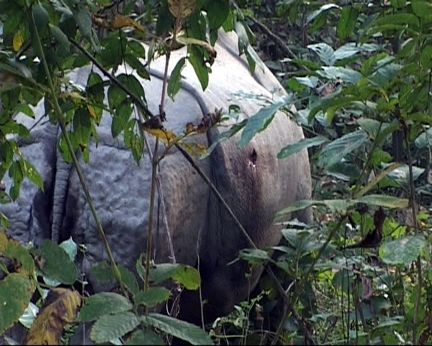Vision
John Eickert
The dripping humid heat was oppressive and became erotic. My sweat soaked shirt and shorts clung to me as if a second skin. The moist air was thick and difficult to breathe. We walked down an old jeep track, my Manas wildlife
guide and I, hoping to spy something a bit more exciting than deer or vultures. Our sandaled feet created a soft patter on the packed-soil parallel pathway. My guide, “M” as he asked to be called, as he was certain I would be unable to pronounce his name,
assured me there would be gaur ahead. He took other tourists to them just several days ago. He was confident and self-assured. I just hoped to see, something.
A loud dramatic clamor issued from the bush ahead and to the right of our path. The sound, similar to a very, very large human nose cleared with force of heavy moist debris, caused us to freeze in place. I did not even
breathe. Though new to India wildlife viewing, I knew from instinct the sound was a warning and the warning giver was large. We waited. The telling sound came again, this time accompanied by an immense crashing. My heart pounded against my chest, which forced
me to take a deep breath. I looked about for a tree or some other refuge. M did too.
The noise of breaking branches and trampling elephant grass subsided. M looked to me and me to him. We both smiled and then laughed. He mimicked, using a finger to his nose, with the finger rising from the top of the nose
at an angle. I understood. We just missed seeing or being run over by an Indian One Horned Rhinoceros. Two days before, I rode an elephant into some marshland and saw my first rhino from a perch aboard that elephant. I looked down on that rhino. Now I considered
the consequence of meeting one eye to eye. All rhino are notorious for their poor vision, coupled with an instinctive desire for privacy, which can at times make them dangerous. I decided then that morning, the best way to view rhino was from the back of an
elephant, M agreed with me.

The rhino faces extinction throughout India and Southeast Asia. Poachers slaughter them to sell the horn for profit while humans expand onto rhino habitat hoping for a place to live, a home. The needs of humanity fall heavy
on the Indian One Horned Rhino. As mankind goes crashing into our own future, can we use sightlessness as an excuse? I encourage all to find time, this year, and try to spot a rhino in the wild, take your children. The opportunities to trek and raft come and
go, but wildlife viewing in the modern world has taken a new sense of urgency. India contains numerous locations to observe rhino in their natural setting. Take the time and go there this year. As always, when you take the time, take your time. Cheers.
(Photograph of injured rhino in Chitwan National Park, Nepal by
Susan Sharma)